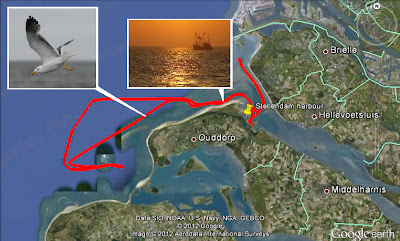Conversations by people from the TV and Radio were also introduced: to interview the crew, biologists and tourists on board. Chris Vemer of the radio program 'Chris Natuurlijk' of Radio Rijnmond was present at the scene this day. She interviewed me as well and you can listen to my part of the interview in Dutch following this link:
Broadcast August 4 Chris Natuurlijk
It's always nice to hear that people are interested in the North Sea and all that is living in it. Though no porpoise showed... Marko of Delta Safari did spot two porpoises on August 1st close to the coast. Thumbs up!
 |
| GPS track of the trip of July 31st |
 |
| Common Tern in flight |
 |
| Creative photograph of Lesser Black-backed Gulls |
Leaving the mudflats again we went on to the gullies, while I was tracking the whole trip with GPS to log the parts of the Voordelta and the North Sea that we were covering. And in particular, to collect the coordinates when a porpoise spurts or wheels across the waves. Next to the GPS-track, I logged the average speed, maximum speed and moving time of the Sirius as well. We crossed 89.3 kilometers, with an average speed of 11 km/h and a maximum speed of 33 km/h. The trip lasted for at least 7hr 54 minutes. That is quite some time to observe the natural habitat of the Harbour Porpoise, in all it's glory, at least above the water surface. Sadly enough lots of porpoises strand and die due to variable external influences, like fishery, pollution and loud underwater noises. Well, that's a story for another day...
To show more of the habitat of the North Sea, I found a movie of NoordzeeTV by Stichting De Noordzee, which also concentrates on what can be seen below the water surface, the scenery of Harbour Porpoises and even White-beaked Dolphins. All in all a wonderful nature reserve in the Low Lands of Europe.
